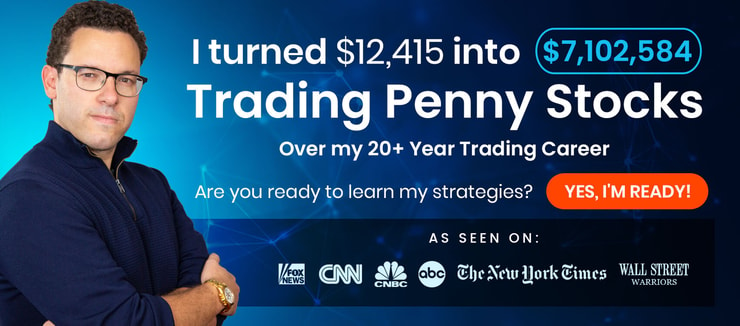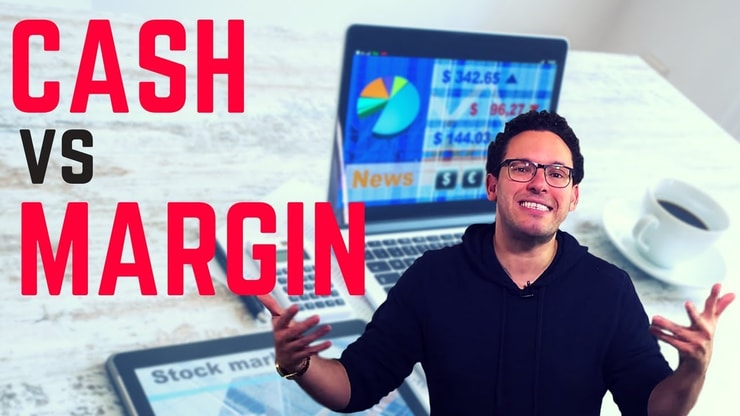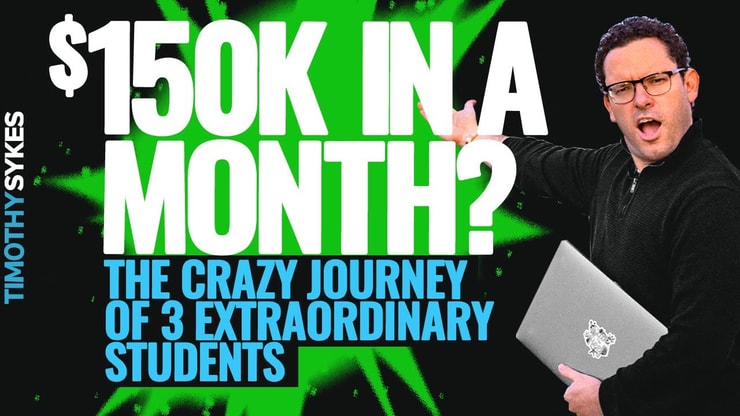- In the stock market, stock leverage trading is borrowing capital from a broker to increase position size.
- Traders use leverage to potentially make more money — but there’s a serious risk. Learn more in this post.
- You don’t need leverage to grow a trading account. Check out what I’ve done in 20+ years of trading.
Full disclosure: I’m not a fan of using stock leverage. I don’t like buying on margin, and neither do most of my top Trading Challenge students. But you need to understand leverage trading to trade smarter.
The idea behind leverage trading is to increase your potential reward. The BIG problem? It doesn’t always work out. And it can prove dangerous for your trading account — especially when you’re new to the stock market.
I prefer to keep things simple. I buy, sell, and sometimes short stocks — mostly penny stocks — for short-term profits.
But too many traders don’t how to buy stock with leverage or understand buying on margin. Bottom line: I caution against using leverage or trading on margin.
Read on to learn what stock leverage is, how trading stocks with leverage works, and why it’s not the best idea.
Table of Contents
- 1 What Is Leverage in the Stock Market?
- 2 How Does Stock Leverage Work?
- 3 Leverage Is a High-Risk Strategy
- 4 What’s the Maximum Leverage in the Stock Market?
- 5 What Are the Most Common Types of Leverage?
- 6 Buying on Margin
- 7 What Is Buying Power With Margin?
- 8 What Is the Dreaded Margin Call?
- 9 Different Situations in Which Traders Can Use Leverage
- 10 How to Trade Stocks With Leverage
- 11 Risk of Excessive Real Leverage in Forex Trading
- 12 Should You Use Leverage in Stocks?
- 13 Stock Leverage: The Bottom Line
What Is Leverage in the Stock Market?
In the stock market, stock leverage trading is borrowing shares from your broker to increase your position size. It’s so you can potentially make more money.
Options trading, futures contracts, and buying on margin are all examples of leverage trading. But buying on margin is perhaps the riskiest.
When you buy on margin, you’re essentially financing your position in the stock.
It’s just like buying a car. Say you want a new SUV and you talk the salesperson down to $30,000. You don’t have $30K in cash, so you put $2,000 down and finance $28,000 over five years…
Every month, you make a payment, which includes the principal (the amount you financed) and the interest (the money you pay to the lender for financing you).
People do this every day with cars and other physical assets, so it doesn’t sound dangerous. But even a car purchase can leave you in financial trouble.
Let’s say you put $2,000 down on your new car and drive it off the lot. Three days later, you total it in an at-fault accident. The insurance company pays the car’s market value, which has already depreciated below what you paid for it. You’re stuck paying off the car even though you don’t have it.
That’s kinda what often goes wrong with leverage stock trading.
How Does Stock Leverage Work?
Stock leverage trading works by allowing you to borrow shares of a stock from your broker.
For example…
Say you have $1,000 to invest. You could invest in 10 shares of Company X stock that trades for $100 per share. But to increase leverage, you could invest the $1,000 in five options contracts. You’d then control 500 shares instead of just 10.
Similarly, you could use buying on margin to increase your leverage. Instead of investing in options contracts, you buy a certain number of shares.
When you exit your position, you have to settle up with your broker. You’re responsible for paying back the broker for the shares you borrowed. Whatever’s left is your profit, minus your initial investment.
What Is Leverage Ratio?
Leverage ratio is the number of shares or dollars your broker is willing to lend to you, compared to your own capital.
Leverage is always expressed as a ratio, such as 2:1. In that case, you could double your position size by borrowing twice what you actually buy.
Let’s look at an example…
2:1 Stock Leverage Example
If you have 2:1 leverage, that means you can borrow twice the amount of your investment from your broker.
For example: Let’s say you want to invest $100,000 in a stock but only have $50,000 in your trading account. Using leverage, you could buy on margin at 2:1. So you’d have $100,000 to invest.
It doesn’t come free, though. You have to make an initial deposit or down payment to your broker for the privilege of buying on margin. It’s sort of like the example of buying a car from earlier. That’s how brokers make money from extending margin.
But what happens to your investment?
Let’s say you buy $100,000 worth of stock at $100 per share. The stock climbs to $103, and you sell.
At that point, you have to return the borrowed shares or money to your broker. The brokerage firm extended $50,000, so you owe that back, plus interest. The rest you keep as profit.
But if the stock price drops and you lose money, you still gotta pay back your broker. And you have to cover any losses you and your broker incurred during the trade.
More Breaking News
- Is Rigetti Computing a Falling Star or a Buy Opportunity After Sudden Plunge?
- Why Opendoor Technologies Faces Challenges After Latest Financial Moves
- Blueprint Medicines: Is It Riding A New Wave of Success?
10:1 Stock Leverage Example
The same rules apply if you use more leverage. Say you use 10:1 leverage…
Some traders want to use leverage when they have a small account. They think they can grow it faster that way by taking bigger positions.
But this can be risky.
Say your account is $500, and your broker gives you margin to trade with. In this example, the stock you want to buy is $5 — you could buy 100 shares. But you think there’s only 20 cents of upside in the trade. So you decide to use leverage to try to increase your profits…
You buy 1,000 shares at $5 for a total of $5,000. If the trade works, you can have a profit of $200 instead of $20.
But say the trade doesn’t work … Or it hits your target but slams down too fast for you to exit at a profit. Then the stock continues below your entry before you can react.
When you exit, you’ve lost 20 cents a share. So for your $5,000 position, you come out with $4,800. But you also still owe your broker the money you borrowed. So they get their $4,500 back plus fees and interest. And you just lost $200 instead of the $20 you’d have lost if you used your own funds.
These stocks can move so fast. You could end up losing far more than you anticipate. That’s why I always say…
Leverage Is a High-Risk Strategy

Just like in gambling, risk increases with reward. The higher the potential payout, the higher your risk for great losses. That’s especially true when you’re trading with leverage — you’re playing with the house’s money, so to speak.
Brokerage firms require margin account holders to maintain a certain minimum balance. Your cash and owned securities serve as collateral for whatever you’ve borrowed, which mitigates risk for the broker.
But it increases your risk. If you borrow too much on a losing position, your account can get wiped out in a flash.
Or ignore my lessons & try to trade big without rules/experience & you'll learn the hard way why I teach what I teach. So, you can either listen to me or learn in a much more expensive/confusing fashion with the market as your teacher, you choose & realize experience is the key!
— Timothy Sykes (@timothysykes) June 15, 2020
What’s the Maximum Leverage in the Stock Market?
Maximum leverage is the biggest position you can take based on your amount of margin. Margin requirements vary by market.
Most brokers will only allow you to borrow 50% of the value of your position for trading stocks with leverage.
Trading forex or futures can have a higher allowable margin. So maximum leverage can be quite high. With forex, it could be up to 400 times. That means small fluctuations in the market can result in you wiping out your account much quicker.
What Are the Most Common Types of Leverage?
Leverage refers to borrowing funds to invest.
Businesses or companies can use leverage to purchase assets or invest in product development. They may do that rather than offering more shares to raise money.
Some of these companies can become highly leveraged — they have high debt and be risky investments. That’s something to consider when doing fundamental analysis.
In trading, the most common type of leverage is margin. Margin is a type of debt. It’s the amount your broker is willing to lend to you to invest. Once you use it, you’re using leverage.
Buying on Margin
Buying on margin simply means borrowing securities or assets from someone else to execute a transaction.
In the stock market, you’re usually borrowing from your broker in exchange for interest paid on the securities. You can typically borrow 50% of the stock’s purchase price.
But that’s not required. You might decide to borrow just 5% or 10%. Buying on margin at lower percentage rates can help you manage your risk tolerance … but remember there’s always a risk.
You need a margin account to exercise leverage. This is different from a cash account. You’ll usually have a minimum deposit, which starts at $2,000 but can go much higher. Plus, you’ll need to prove certain things to your broker.
Brokerage firms have higher standards for margin accounts such as a certain net worth, for instance.
What Is Buying Power With Margin?
To understand margin buying power, you have to understand equity.
Here’s an example…
Let’s say you bought a house 10 years ago for $200,000. Between your payments toward the principal and your down payment, you’ve now paid $40,000 toward your mortgage. This represents your equity. It’s the amount of money you’ve put into the house as long as the home’s market value holds.
In a margin account, your equity is the amount of cash in your account. Typically, your margin buying power increases with your equity.
So, if you have $100,000 in equity in your margin account, your margin buying power could be $200,000 (your equity plus margin at 2:1).
Your margin buying power changes as you execute trades, though. Here’s another example: Let’s say you buy $10,000 worth of shares in a stock, decreasing your equity to $90,000. Your margin buying power shrinks to $180,000 as a result.
What Is the Dreaded Margin Call?
The margin call is one of the most disastrous experiences for any trader or investor. It happens when your equity drops below a specific point, and your broker requires you to make up the difference by depositing cash in your account or selling securities.
Many margin accounts have a maintenance margin requirement of between 30% and 40%. In other words, you can borrow up to 50% percent, but you have to maintain a 30% or 40% margin.
In short, margin calls force traders to either put more cash into their accounts or liquidate their positions.
Margin Call Example
Example time again: Say you buy $10,000 worth of shares in a stock using $5,000 from your broker and $5,000 of your own cash. You also have a maintenance margin of 30% through your broker.
Then, the worst happens. Your position drops by $6,000. You already borrowed $5,000 from your broker, and you have to maintain that 30% margin. You only have $1,000 of equity in the position, so you’ll have to deposit enough funds to bring your margin back up.
Different Situations in Which Traders Can Use Leverage
There are several situations in which leverage traders can use leverage. You should know about them even if you never use them.
Leverage Trading Stocks
I’ve spent much of this article discussing leverage trading in the stock market. You’re borrowing shares of a specific stock from your broker.
If you imagine shares as little slips of paper — kinda like money — the concept becomes more real. You have a pile of 100 slips of paper — but you want 200. So you borrow 100 from your broker to increase your position.
But what happens if someone — the stock market — takes away your slips of paper? You’re not just losing your own paper, but your broker’s as well. And you’re responsible for the difference.
Leverage Trading Crypto
The crypto market is a little different. It’s based on the lending market. That allows anyone to borrow cryptocurrency, such as bitcoins or altcoins, from a broker, the exchange itself, or a third party.
When you don’t have many coins to start with, leverage trading becomes more attractive.
Like penny stocks, cryptocurrencies are extremely volatile. Their value can shoot up or down without much warning. If you’re not prepared, you could lose a ton of money.
How Does Leverage Work in Forex?
Forex trading involves exchange rates between two currencies, known as pairs. For instance, you might bet that the exchange rate between two currencies will go in a certain direction, then use leverage trading to increase your position size.
Since margin buying power increases significantly in the forex market, you’re more likely to put yourself at risk…
Forex Leverage Example
Let’s say you want to trade $200,000 of currency. In a 100:1 leverage ratio, you’d use $2,000 of your own equity to secure the position, while the other $198,000 would come from your broker.
Now imagine the trade goes south, and you have to pay that amount to your broker…
How to Trade Stocks With Leverage

Personally, I don’t think you should trade stocks with leverage. I’ve made over $7.3 million trading penny stocks. And I started with a small account. More on that in a bit…
If you insist on putting yourself and your trading account at risk, you first need a margin account to trade stocks with leverage.
Once you have a margin account you can take a position using your funds plus your margin.
Did I mention it’s risky? No trade is 100% guaranteed. You always run the risk of losing money that’s not yours.
Even if you have some wins, you can learn the wrong lessons, become overconfident, and take on bigger risks. That can result in larger losses when using leverage.
Risk of Excessive Real Leverage in Forex Trading
With leverage, you typically have more buying power in forex trading.
Many forex accounts let you buy on margin at ratios of up to 50:1. That’s a huge difference from the 2:1 buying power for buying stocks.
With a 50:1 margin-based leverage, you only put up 2% of your own money as equity. The brokerage covers the rest.
For instance, if you want to enter a position with $10,000 of your own money at 50:1 leverage, you could gain control of a position worth $500,000…
That might sound attractive, but it comes with more risk. Remember, as your reward increases, so do your potential losses.
Resist the urge to buy on margin with a position you can’t comfortably cover. Never invest money you can’t afford to lose.
ANYONE can learn to make $2,000, $5,000+, even $50,000-$250,000+ in a day in this hot market, but FIRST you must learn the basics & how to trade with a small account. Only size up your positions AFTER you have honed trading with small size, do not be greedy & trade big right away
— Timothy Sykes (@timothysykes) June 15, 2020
Should You Use Leverage in Stocks?
Nope. In my opinion, leverage trading is a slippery slope.
When investors become too dependent on margin accounts, they lose sight of the bigger picture. They get more confident in positions where they shouldn’t.
It’s the same reason I don’t gamble. I like to know what my money’s doing in the stock market. I want to know I don’t owe anyone else if my position goes sideways. It’s why I trade small and conservatively, cut losses quickly, and take singles.
I’ve been trading for over 20 years. And while the market changes, my patterns largely stay the same.
Focus on the rules and the process. Learn how stocks move and why. Take time to build your knowledge account and you can slowly build your money account. It takes time. My top students like Jack Kellogg, Matthew Monaco, and Kyle Williams all took a few years to learn the process.
But in a hot market, that discipline is key. Check it out:
I never recommend that new traders use margin. You should never risk more than you can afford to lose. And when it comes to using margin, you’re using someone else’s money.
Should You Join My Trading Challenge?
My Trading Challenge isn’t for everyone. It’s only for the most dedicated students. That’s why I make people apply. I don’t accept everyone.
But if you want to learn how to trade like I do, apply today. In the Challenge, you get access to live trading sessions, all my video lessons and DVDs, plus you get to hang with top traders in the best chat room ever.
Not quite ready for the Challenge? Start with some of my other resources, like the thousands of videos I’ve posted on YouTube. There’s my FREE penny stocks guide. Or my book on how I got into trading, “An American Hedge Fund” — you can get your copy free of charge.
There’s also “The Complete Penny Stock Course” by my student Jamil. It goes over my complete strategy.
Also, check out my no-cost “Volatility Survival Guide” and my new Supernova Alerts. There are so many ways for you to learn. It’s up to you to commit.
Stock Leverage: The Bottom Line
Leverage trading is a dangerous game. Buying on margin can put your entire trading account at risk, especially if you’re trading too much of your total net worth.
I don’t recommend buying on margin, but some people swear by it.
Maybe they wanna go bankrupt in one bad trade. People are into all kinds of weird things…
I don’t think anyone who wants to be a self-sufficient, smart trader should try it. But it’s good to know what it is and who might use it.
Do you use leverage trading stocks? Why or why not? Let me know in the comment.








Leave a reply